Ecological Focus Areas
Date published: 17 March, 2022
For recent changes to this guidance, please see the bottom of the page.
This guidance is effective from 1 January, 2022.
Table of Contents
- What is an Ecological Focus Area?
- I'm organic – am I exempt?
- Do the EFA requirements apply to me?
- What counts as arable land?
- How much does each of these options contribute to my EFA commitment?
- Where can I put my EFA?
- Mapping requirements
- Types of EFA
- EFA fallow land (EFAFAL)
- EFA margins (EFAM)
- EFA catch crop (EFACC)
- EFA green cover (EFAGC)
- EFA nitrogen-fixing crops (EFA-NFIX)
- EFA hedges (EFAH)
- EFA agro-forestry (EFAAF)
- General tips for all EFA options
- Flexibility under Greening rules
- Recent changes
- Previous versions
- Download guidance
What is an Ecological Focus Area?
An Ecological Focus Area (EFA) is an area of land upon which you carry out agricultural practices that are beneficial for the climate and the environment.
The main aim of an EFA is to improve biodiversity.
There are seven EFA options that can be used on their own or in combination to meet the EFA requirement:
- fallow land
- margins
- catch crops
- green cover
- nitrogen-fixing crops
- hedges
- agro-forestry
If the EFA requirements apply to you, it means at least five per cent of your calculated arable area must be put into one or more of the seven types of EFA.
You will not be penalised for claiming and managing more than five per cent of EFA.
I'm organic – am I exempt?
If all of your holding (all of the land claimed on your Single Application Form) is certified as organic or in organic conversion, the Ecological Focus Area (EFA) requirements do not apply to you.
If part of your holding is certified as organic or in organic conversion, the claimed areas that are not certified as organic or in organic conversion need to be considered for your EFA requirements.
If your holding is only partly organic, you may choose not to benefit from the exemption for organic land. Instead, you may choose to meet your Greening requirements across all of your arable land.
For the Organic clause to apply, you must submit your Organic certificate with your annual SAF application each year.
Do the EFA requirements apply to me?
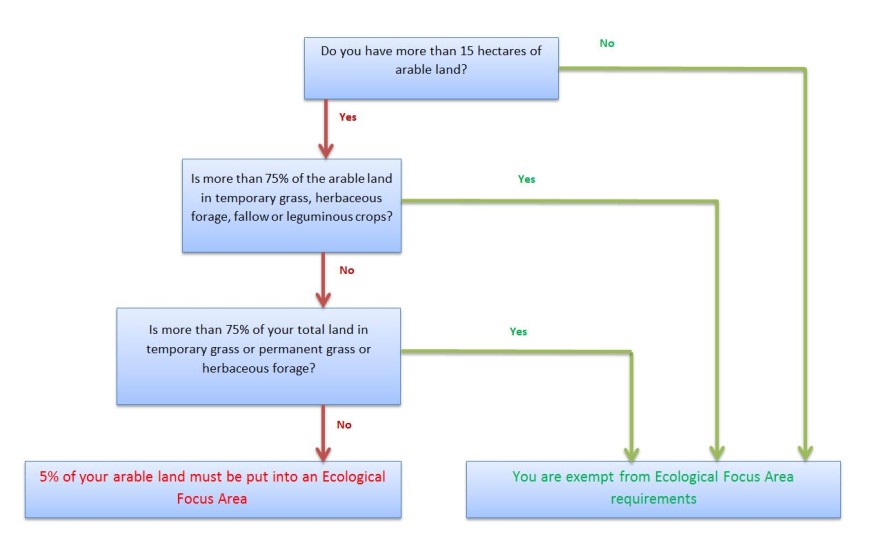
We have also compiled a table in Annex A which you will find helpful in identifying your EFA requirements. Areas of land are those claimed for the Basic Payment Scheme.
For Cross border businesses submitting a BPS/Greening claim for land in Scotland, only the land declared on the Scottish SAF is included in the calculations.
What counts as arable land?
For the purposes of calculating your EFA requirement, your arable land must include all of the land used to grow arable crops, fallow, temporary grassland, leguminous crops and herbaceous crops that you claim for the Basic Payment Scheme.
If you use some of your permanent grassland area as EFA (for example, a margin) this means that this area of EFA on your permanent grassland is now classed as arable land for the purposes of the Greening calculation only. You will claim it as permanent cover on your Single Application Form and it will be added to your total arable area calculation. An example would be:
Total area of holding = 125 ha
Total arable area = 100 ha
EFA is 5% = 5 ha
If all the five hectares of EFA is sited on permanent grassland this would now become arable and would be added to give your new total arable area, for the purpose of Greening only.
Therefore: (original total arable area) 100 ha + 5 ha (EFA) = 105 ha (new total arable area). New area of EFA required is now 5.25 ha. 5% of 105 ha.
When calculating your arable area you should ensure that you include any land that is fallow, any land in an EFA margin and any land that is currently in an agri-environment scheme that does not allow production, which was formerly arable. For example:
- beetlebanks
- grass margins
- water margins where grazing is excluded
Permanent crops are not included in the calculation of your arable area (see the Glossary for a definition of permanent crops).
How much does each of these options contribute to my EFA commitment?
The European Commission has set out a number of weighting factors for the different types of EFA which will contribute to each EFA option. Since leaving the EU the Scottish Government has retained these weighting factors. These factors allow for the fact that certain types of EFA deliver higher levels of environmental benefit.
When calculating your EFA obligation you will measure the actual area of the EFA feature and multiply by the appropriate weighting factor to give the equivalent area of EFA. The weighting factors are:
| EFA | Location | EFA option code | EFA contribution |
|---|---|---|---|
| Fallow (area in hectares) | On arable land | EFAFAL | 1 |
| Margins (area in hectares) | On, adjacent to or within five metres of arable land or contiguous to a claimed EFA option | EFAM | 1.5 |
| Nitrogen-fixing crops (area in hectares) | On arable land | EFA-NFIX | 1 |
| Catch crop (area in hectares) | On arable land | EFACC | 0.3 |
| Green cover(area in hectares) | On arable land | EFAGC | 0.3 |
| Agro-forestry (area in hectares) | On BPS eligible land in 2015 | EFAAF | 1 |
| Hedges (length in metres) |
On, adjacent to, or within five metres of arable land or contiguous to a claimed EFA option: Hedges (length in metres) If the producer has the right to claim the whole (eligible) hedge the EFA contribution to be applied is | EFAH100 | 10 m2 |
|
On, adjacent to, or within five metres of arable land or contiguous to a claimed EFA option: Hedges (length in metres) If the producer has the right to claim only half the hedge the EFA contribution to be applied is | EFAH50 | 5 m2 |
For example, spring barley under-sown with grass as a catch crop with a weighting factor of 0.3 – this means that 10 hectares of catch crop counts as 3 hectares towards your EFA requirements.
Where can I put my EFA?
To be eligible to support EFA the land must be:
- used by the claimant
- on (or for EFA hedges adjacent to) a claimed agricultural parcel
- on (excluding EFA hedges) Basic Payment Scheme eligible land
You must locate your EFA fallow, EFA catch crop, EFA green cover and EFA nitrogen-fixing crops on arable land (EFA Agro-forestry on BPS eligible, arable land in 2015).
EFA margins and EFA hedges must be on, adjacent to, or within five metres of arable land or contiguous to a claimed EFA option.
The following are two examples of how you can meet the above requirements:
Diagram 1 (below) in this example the hedge is being claimed as an EFA Hedge as it is contiguous to a claimed EFA option, which is an EFA margin.
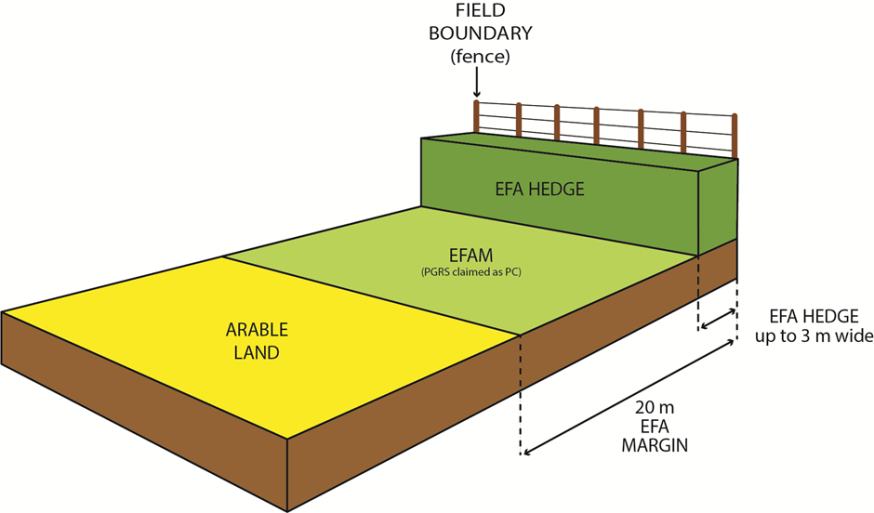
Diagram 2 below shows an EFA margin on permanent grassland (claimed as land use PC) within five metres of arable land.
In this example the road is less than five metres wide and the hedge may or may not be claimed as an EFA Hedge so can be included in the EFA margin area.
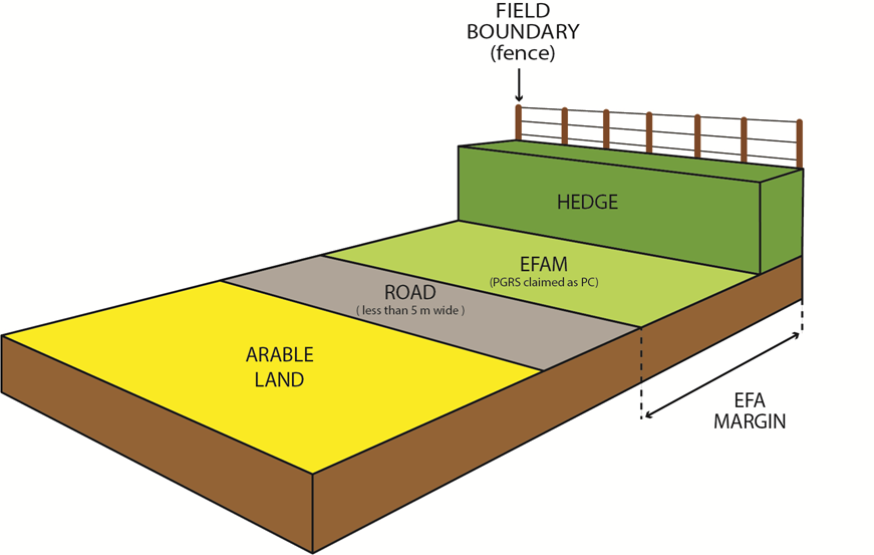
If you want to include areas in your EFA that are currently part of an agri-environment scheme you can do this. However:
- you must ensure that the management of the two schemes are compatible
- the payment you receive for your agri-environment scheme may be reduced to reflect the Greening payment you receive for your EFA feature
- there may be delays in the payment of your Basic Payment as both schemes will need to be validated
Mapping requirements
We have introduced a new Map viewer to improve the mapping data available. This Tutorial Videos page explains its functionality.
If you undertake any EFA on your holding, it is mandatory that you submit a map detailing the type, location and size of each EFA feature with your notes regarding EFA areas must include the following, where appropriate:
- LPID
- EFA option name
- area
- width
- length
You only need to include the field(s) with EFA options on them to meet your EFA map requirement.
If you have several parcels with EFA options on them, you can create individual maps if the parcels are some distance apart. This will allow for more detailed and clearer maps.
Your EFA map is a mandatory supporting document and must be submitted with your SAF. Failure to provide an EFA map will result in a payment reduction.
With the introduction of the Map viewer we have introduced a new facility to submit EFA maps.
An EFA feature which is an area that can be drawn on your EFA map using the EDIT EFAs layer on the External Viewer through the customer facing RP&S portal.
The following diagram shows an example of an EFA map showing two claimed EFA margins in blue: created using the new EFA function:
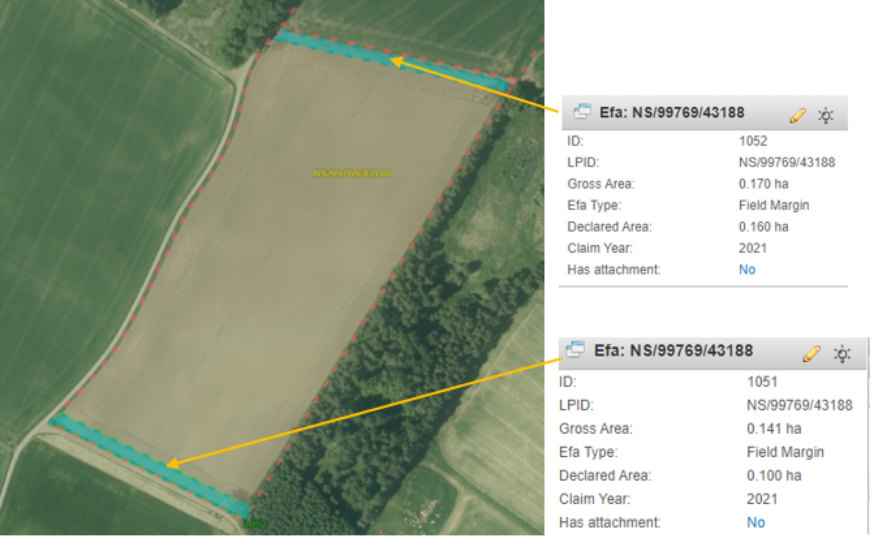
How do I draw an EFA Hedge on my EFA map?
An EFA Hedge is a linear feature therefore it can be drawn on your EFA map as a line using the New Linear EFA function.
A hedge is measured in metres and must be a minimum length of 20 metres to be claimed.
The following is an example of an EFA map showing two EFA Hedges (the pink dotted line). The bottom hedge is owned and managed only by the claimant and is fully within the parcel so is eligible to be claimed as EFAH100.
If the EFA hedge is a boundary / ‘march’ hedge between two applicants, then it will be claimed as EFAH50, (in this example the right hand pink line). For both EFAH100 and EFAH50 you would still draw the EFA hedge as a line on the map as shown in the example.
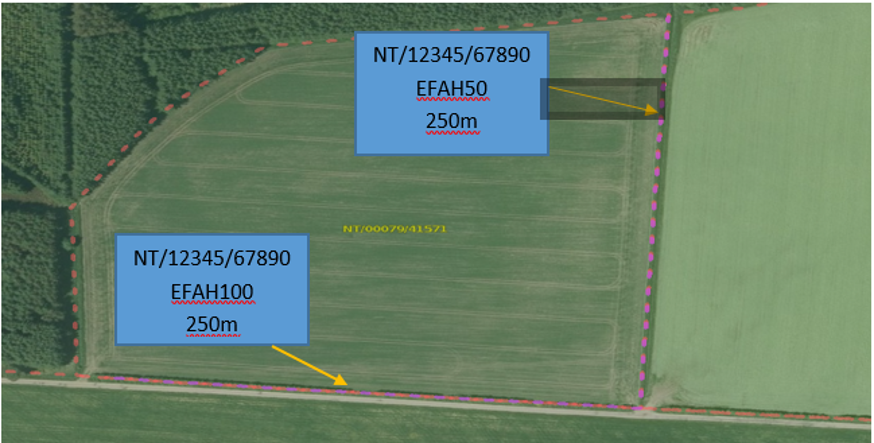
This is how the features will appear on the EDIT EFA section at the bottom left hand of the screen in the Map viewer.
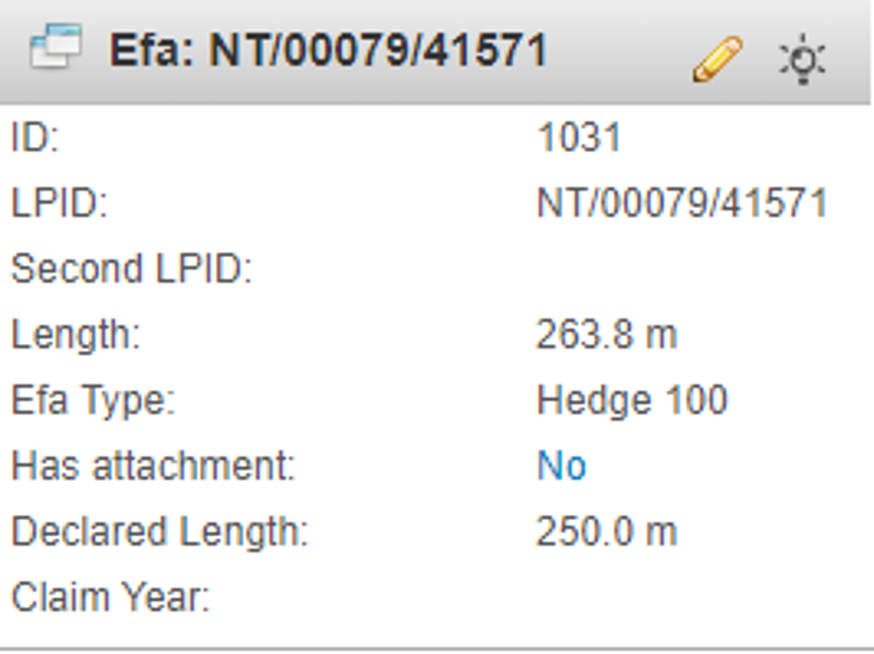
The following is an example of an EFA map showing an area of Fallow - EFAFAL.
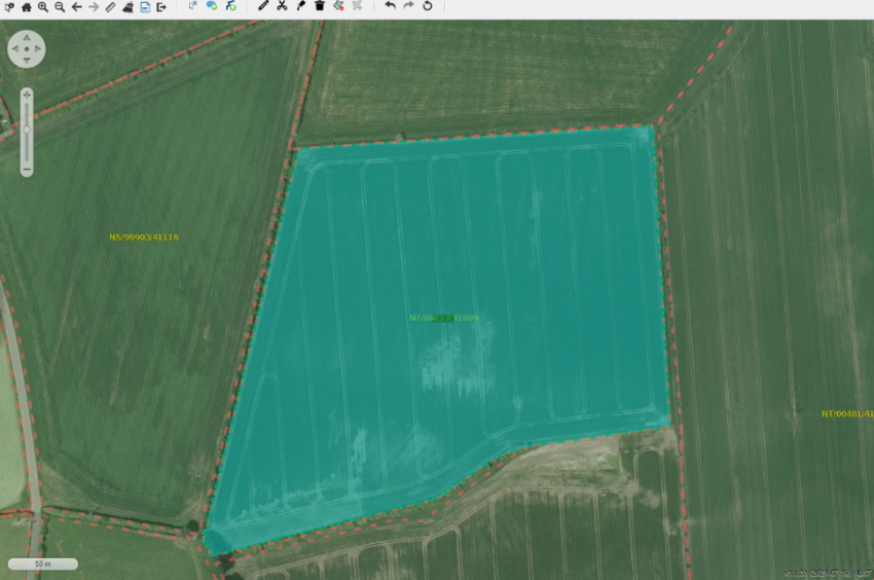
Types of EFA
The following sections describe each type of EFA. Each EFA option has its own unique management requirements. You should consider carefully which EFA options you wish to implement to suit your circumstances.
EFA fallow land (EFAFAL)
EFA fallow land is arable land that has no crop production or grazing on it from 15 January to the 15 July inclusive.
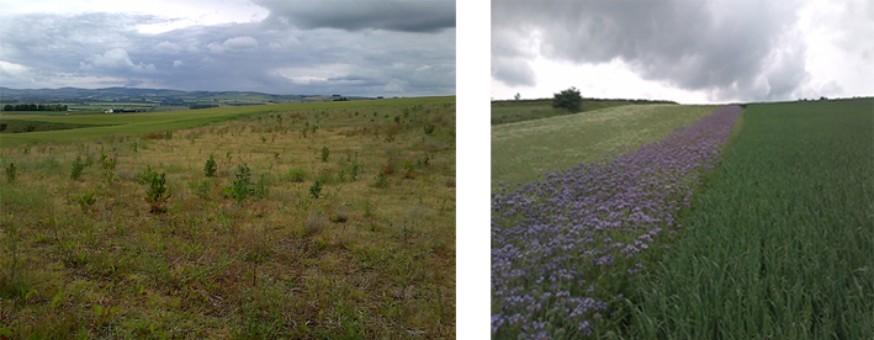
Above pictures: (left) EFA fallow – example of natural regeneration and (right) EFA fallow –example of wild flower mix (two species)
What land is eligible to support EFA fallow?
Your land:
- must be arable land
- must be on your holding, on a claimed, Basic Payment Scheme eligible, agricultural parcel and claimed on your Single Application Form
- must have been in the preceding year fallow or an arable crop (including temporary grass)
- must be a minimum of 0.01 hectares in size
- must be clearly identifiable and distinguishable on the ground from 15 January to 15 July inclusive
Requirements for EFA fallow
You must:
- submit an EFA map with your Single Application Forms, detailing the location and size of your EFA fallow land See EFA mapping requirements
- control injurious weeds, invasive weeds and other weed species by spot herbicide application or hand roguing (see details of GAEC in the Overview)
You must not:
- apply any plant protection products to the area of fallow from 15 January to 15 July inclusive, except by spot herbicide application for injurious weeds, invasive weeds and certain other weed species (refer to the Overview for guidance on GAEC requirements)
- undertake agricultural production between the dates of 15 January to 15 July inclusive. For example, this includes areas of land used in the establishment and growing of a crop
- you must not store materials (including but not exclusively irrigation pipes, fuel bowsers, seed boxes, bales)
- you must not use for the turning of machinery
- you must not use for access (except for occasional use)
- undertake new drainage schemes in the period 15 January to 15 July (see flexibilities for maintenance of field drains below)
- change the land cover within the fallow period 15 January to 15 July inclusive with the exception of establishing a wild flower or wild bird seed mix
- top the fallow between the dates of 15 January to 15 July inclusive
- apply any fertiliser, except to aid in the establishment of a wild flower mix or a wild bird seed mix in the area of fallow from 15 January to 15 July inclusive
You are allowed to:
- claim temporary grass as EFA fallow if it has been declared as TGRS in no more than the five previous years (see table below)
- change the ground cover to establish a wild flower or wild bird seed mix within the fallow area
- temporarily store farm yard manure for that field
- undertake maintenance of field drains in the period 15 January to 15 March, this is limited to investigation (inspection pits, etc.) and replacement of pipes or tiles where existing ‘bursts’ have been identified
- in exceptional cases (subject to prior approval) you may undertake maintenance of field drains in the period 15 March to 15 July. In such cases you must seek prior written approval from your local area office to undertake drainage which will only be approved if you can demonstrate that the works are essential and immediate (recently identified after heavy rain)
| Year | 2016 | 2017 | 2018 | 2019 | 2020 | 2021 | 2022 |
|---|---|---|---|---|---|---|---|
| Land use | SB | TGRS1 | TGRS2 | TGRS3 | TGRS4 | TGRS5 | FALW |
| EFA option | 0 | 0 | 0 | 0 | 0 | EFAFAL | EFAFAL |
|
Helpful tips for EFA fallow land • if you choose to put temporary grass in fallow the land retains its arable status for the period it is claimed as EFA fallow even if the grass is more than five years old • if you’ve claimed temporary grass as EFA fallow in one year and decide not to claim this as EFA fallow in the following year, it will revert to being temporary grass if it’s five years or younger, or permanent grass if it’s older than five years • you may be asked to provide a seed label if one element of your wild bird seed mix or wild flower mix fails, to prove eligibility • if weed control is a problem, then you may consider establishing a wild flower mix or wild bird seed mix to aid weed control. See the overview for guidance on GAEC requirements |
EFA margins (EFAM)
Margins provide an important habitat for farmland biodiversity, contribute to wildlife and ecological networks and benefit water quality from 1 January to 31 December inclusive.
What land is eligible to support EFA margins?
Your land:
- must be on, adjacent to, or within five metres of arable land or contiguous to a claimed EFA option
- can be around the margin of a field or splitting two crops within a field
- must be on your holding, on a claimed, Basic Payment Scheme eligible, agricultural parcel and claimed on your Single Application Form
- must be between one and 20 metres wide
- must be a minimum of 0.01 hectares in size
- must be clearly identifiable and distinguishable on the ground from 1 January to 31 December, inclusive
Requirements for EFA margins
You must:
- submit an EFA map with your Single Application Form, detailing the location and size of your EFA margins. See Mapping requirements
- control injurious weeds, invasive weeds and certain other weed species by spot herbicide application or hand rogueing. You must not breach GAEC – refer to the Overview for guidance on GAEC requirements
You must not:
- apply any plant protection products to the area of margin from 1 January to 31 December inclusive, except by spot herbicide application for injurious weeds, invasive weeds and other weed species (refer to the Overview for guidance on GAEC requirements)
- apply any fertiliser with the exception that you may apply fertiliser to aid the establishment of a wild bird seed mix, wild flower mix or grass
- clean ditches and spread the spoil on any area which has been claimed as an EFA margin
- graze the margin if it contains or is adjacent to a watercourse (to avoid diffuse pollution).
- store materials (including but not exclusively irrigation pipes, fuel bowsers, seed boxes, bales)
- use for regular access (except for occasional use including for Hay and Silage)
You are allowed to:
- change the cover to establish a wildflower mix, wild bird seed mix or a grass sward
- apply fertiliser to aid establishment of wild bird seed mix, wild flower mix or grass
- cut after 15 July (including for silage or hay)
- graze after 15 July, if the margin does not contain or is not adjacent to a watercourse
|
Helpful tips for EFA margins • hedges and ditches defined as eligible landscape features (hedges up to three metres wide and ditches up to two metres wide) under GAEC, may be included as part of an EFA margin • if you have existing beetle banks created under a previous agri-environment scheme this can be included in an EFA margin. However this may result in potential double funding and a reduction in your agri-environment payment • if land was sown out a number of years previously and is now permanent grassland (i.e. more than five years old) the area is still eligible for an EFA margin if it is within five metres of arable land • if the area of the EFA margin includes land ineligible for your Basic Payment this must be deducted from the area of the EFA margin claimed • any permanent grassland claimed as an EFA margin is considered as ‘arable’ for the purposes of the Greening calculation (EFA and crop diversification) and should be claimed as permanent cover on your Single Application Form • if the EFA margin splits two crops these can be the same crop (such as a field of winter barley split in two by an EFA margin) |
Examples of EFA margins
The following illustrations provide examples of EFA margins. Please note – these are indicative examples to help you when considering your EFA requirements. If you are unsure if your chosen area is eligible to count towards an EFA margin, please contact your local area office with details and they will provide further guidance.
Example one – EFA margin in an arable field
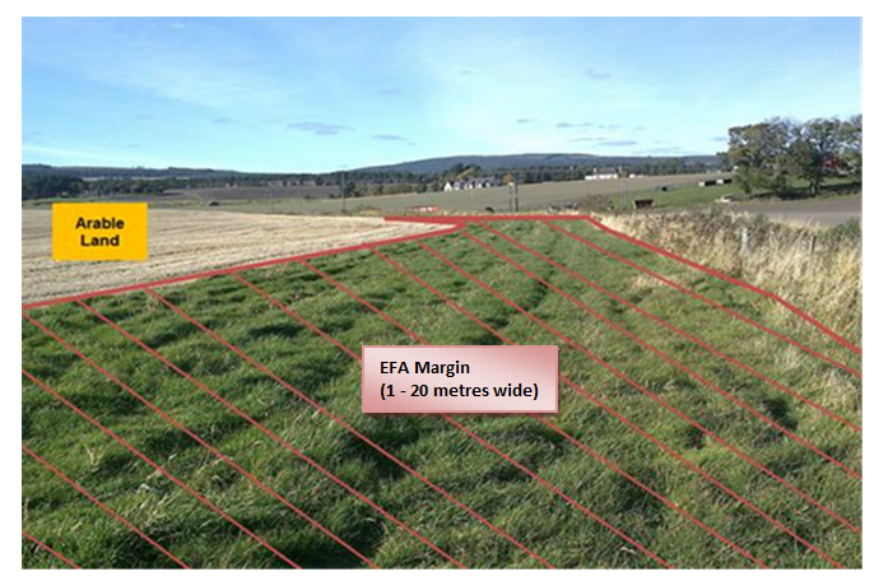
Above is an existing grass margin (possibly a former agri-environment option or a margin established in grass) running from the fence to the edge of an arable crop. The EFA margin is between one and 20 metres wide on arable land.
Example two – EFA margin adjacent to hedge including GAEC strip and Basic Payment Scheme eligible landscape feature
In the example below an EFA margin has been claimed and is EFA eligible as it is adjacent to arable land. The EFA margin is between one and 20 metres wide and is claimed as PC as it is on permanent grassland.
To be aware:
In this instance, there is a GAEC requirement to maintain a two metre wide, uncultivated strip from the centre line of the hedge.
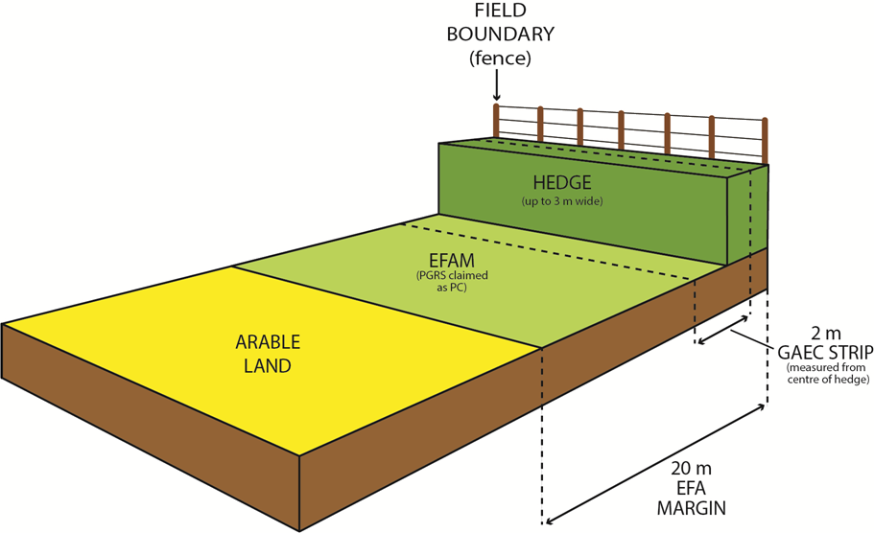
Example three – margin and hedge both claimed as EFA
The example below shows the hedge is eligible to be claimed as an EFA hedge as it is contiguous to the EFA margin (see guidance on Where can I put my EFA).
In this example the hedge is being claimed for EFA, noting any hedge up to three metres wide is eligible as an EFA hedge.
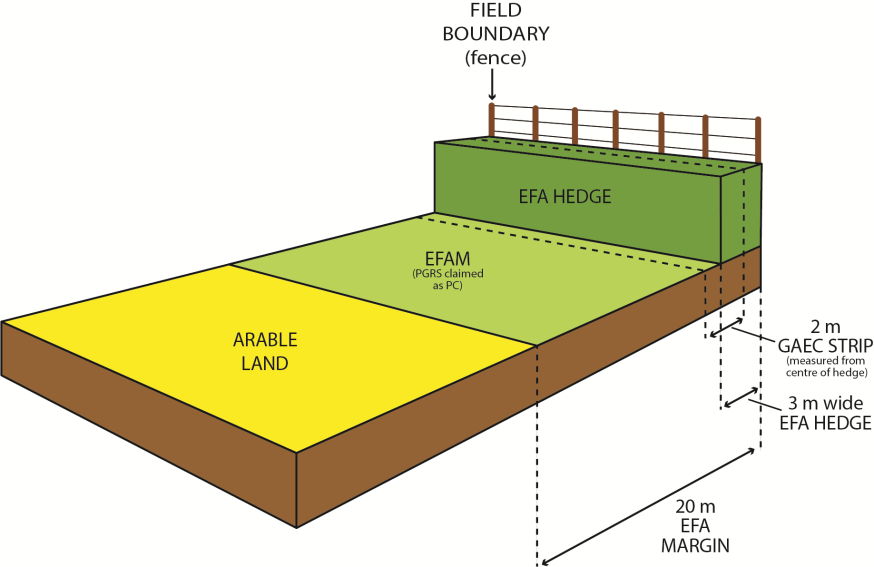
Example four – BPS eligible landscape feature included within the EFA margin
In the example below, the farmer has chosen to include an area from the fence to the edge of the cropped arable land.
This includes, as part of the EFA margin, the water feature as it is less than two metres wide (a Basic Payment Scheme eligible landscape feature) and the two metre wide, uncultivated GAEC strip for the water feature.
The two metre wide GAEC strip starts at the top of the bank (not from the water’s edge). Refer to the Overview for guidance on GAEC requirements.
This permanent grassland, if claimed as an EFA margin, is considered as ‘arable’ for the purposes of the Greening calculation and should be claimed as Permanent Cover (PC) on your Single Application Form.
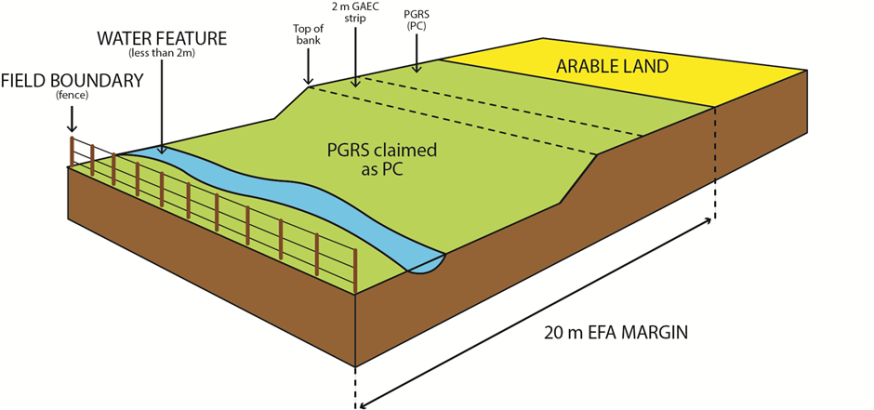
Example for implementing the five metre adjacent rule for an EFA margin
Example 5 - claimed EFAM within 5 metres of arable land, note the watercourse is an ineligible landscape feature and must be deducted from the EFA margin.
In the example below a parcel of arable land has a three metre road on its boundary. The applicant wishes to claim an EFAM on an adjacent parcel using the five metre adjacent rule.
- Where do I start measuring the EFA margin from?
We would start measuring from the fence as the eligible land cover is within five metres of the arable land.
This width would be restricted to a maximum of 20 metres from this point. Any ineligible features found within this area would be excluded from the found area.
In this example, the EFAM claimed area is 20 metres wide however, as the watercourse is three metres wide (which makes it ineligible for BPS), it’s area will need to be deducted from the overall area of EFAM to establish a net eligible area of EFA.
As the Permanent Grass (PGRS) is within five metres of arable land, we would claim this EFA supporting land cover as Permanent Cover (PC) and we would not include the road in the EFAM area.
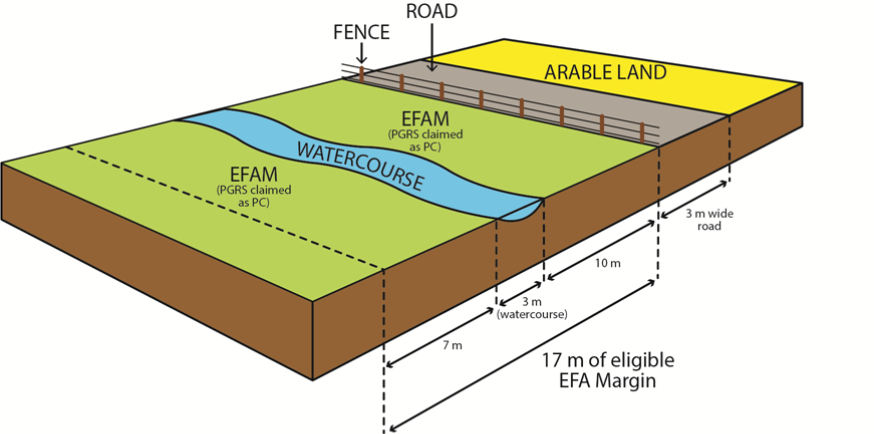
EFA catch crop (EFACC)
In Scotland, the only catch crop you can grow will be a cereal nurse crop with under sown grass as the catch crop. A catch crop will provide an enhancement to biodiversity and prevent soil erosion.
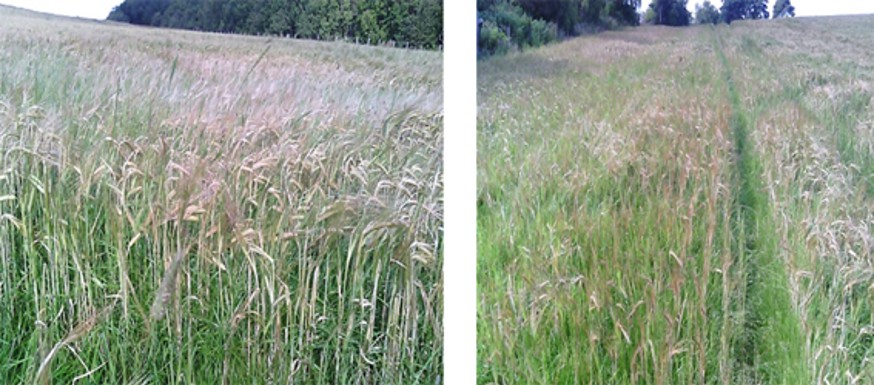
Pictures above: EFA catch crop – barley under-sown with grass
What land is eligible to support EFA catch crop?
Your land:
- must be arable land
- must be on your holding, on a claimed, Basic Payment Scheme eligible, agricultural parcel and claimed on your Single Application Form
- must be a minimum of 0.01 hectares in size
- must be clearly identifiable and distinguishable on the ground
Requirements for EFA catch crop
You must:
- submit an EFA map with your Single Application Form, detailing the location and size of your EFA catch crop. See EFA Mapping Requirements
- the nurse crop will be under sown in the Spring with a recognised grass seed mix
- maintain the EFA Catch Crop up to the 31 December inclusive
You must not:
- use plant protection products from the date of harvest of the nurse crop to 31 December inclusive
- incorporate and sow any EFA catch crop to a winter crop in the autumn (prior to 31 December) of the year that it is claimed as an EFA
You are allowed to:
- graze the EFA catch crop after harvest of the nurse crop
|
Helpful tips for EFA catch crop • Arable Silage for Stock Feed (ASSF) is not eligible for EFA catch crop, as it is not a main crop as defined in the Regulations • it would be helpful to retain the seed label to prove eligibility, if your EFA catch crop fails |
EFA green cover (EFAGC)
Green cover is the establishment of a temporary crop in the autumn that will provide an enhancement to biodiversity, improve soil structure and will prevent soil erosion.
What land is eligible to support EFA green cover?
Your land:
- must be arable land
- must be on your holding, on a claimed, Basic Payment Scheme eligible, agricultural parcel and claimed on your Single Application Form
- must be a minimum of 0.01 hectares in size
- must be clearly identifiable and distinguishable on the ground
Requirements for EFA green cover
You must:
- submit an EFA map with your Single Application Form, detailing the location and size of your EFA green cover. See EFA Mapping requirements
- establish the EFA green cover by 1 November
- maintain the EFA Green Cover up to the 31 December inclusive
- establish a green cover consisting of two or more of only the following crops: alfalfa, barley, red clover, white clover, mustard, oats, phacelia, radish, rye, triticale, vetch
You must not:
- use plant protection products from establishment of the EFA Green Cover until the 31 December
- incorporate and sow any green cover to a winter crop in the autumn (prior to 31 December) of the year that it is claimed as an EFA
- use EFA green cover to support any agricultural production during the maintenance period 1 November to 31 December inclusive, e.g. no grazing
- take to harvest any crop sown as EFA green cover
|
Helpful tips for EFA green cover • you may be asked to provide a seed label to prove eligibility, if one element of your EFA green cover fails • if you intend to sow your EFA green cover immediately after harvesting another crop, you must remember you are required to establish it by 1 November. If you are in any doubt about your ability to establish the crop by 1 November you should choose another EFA option |
EFA nitrogen-fixing crops (EFA-NFIX)
These are plants that contain symbiotic bacteria called Rhizobia within the nodules of their root systems, producing nitrogen compounds that help the plant to grow and compete with other plants.
When the plant dies, the fixed nitrogen is released, making it available to other plants and this helps to fertilise the soil.
Example one : the picture below shows an EFA nitrogen-fixing crop with an associated claimed EFA margin.
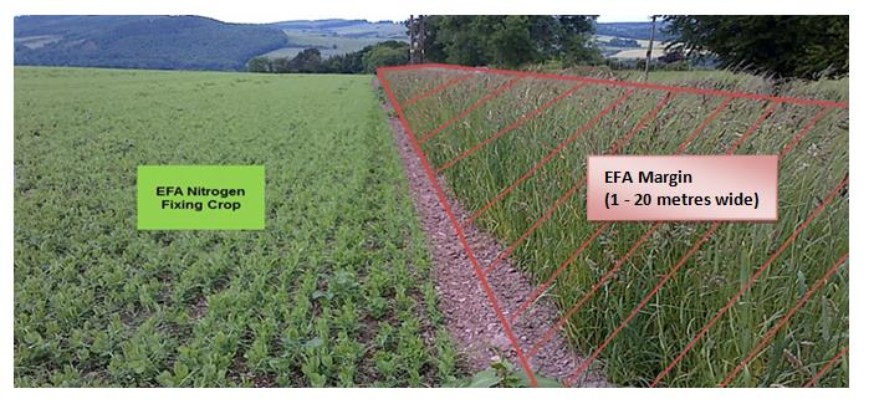
What land is eligible to support EFA nitrogen-fixing crops?
Your land:
- must be arable land
- must be on your holding, on a claimed, Basic Payment Scheme eligible, agricultural parcel and claimed on your Single Application Form
- must be a minimum of 0.01 hectares in size
- must be clearly identifiable and distinguishable on the ground
Requirements for EFA nitrogen-fixing crops
To claim EFA nitrogen fixing crops, you must ensure that there are at least two different claimed EFA nitrogen-fixing crops on your EFA area to extend the flowering period for pollinators.
You must:
- grow two or more of the following nitrogen-fixing crops:
- alfalfa
- beans (including Faba beans)
- birdsfoot trefoil
- chickpea
- red clover
- white clover
- lentil
- lupin
- peas
- vetch - if you wish to include mixtures of nitrogen-fixing crops with other crops for one or both of the EFA nitrogen-fixing crops, you should ensure that the nitrogen-fixing crop species are predominant by weight of seed. The predominant nitrogen fixing crop (for each claimed EFA nitrogen-fixing crop area) should be declared as the Land use
- ensure that the main EFA claimed nitrogen-fixing crop is less than or equal to 75 per cent of the total area of EFA, claimed as nitrogen-fixing crops
- submit an EFA map with your Single Application Form, detailing the location and size of your EFA nitrogen-fixing crops. See EFA Mapping Requirements
- ensure that all your claimed EFA nitrogen-fixing crops are surrounded by a claimed EFA margin. The margin must meet the EFA margin rules, including retention and management until 31 December inclusive.
You must not:
- use plant protection products as they are prohibited on all areas of EFA Nitrogen fixing crops from establishment until after harvest of the nitrogen fixing crop
- harvest the crop before 1 August in order to protect ground-nesting birds
|
Helpful tip for EFA nitrogen-fixing crops • the associated EFA margin must meet the EFA margin rules and be claimed as EFA. If you wish to graze the aftermath of the nitrogen-fixing crops, livestock must be excluded from any EFA margin adjacent to any watercourse |
Example two: the diagram below shows examples of an EFA margin surrounding EFA nitrogen-fixing crop(s).
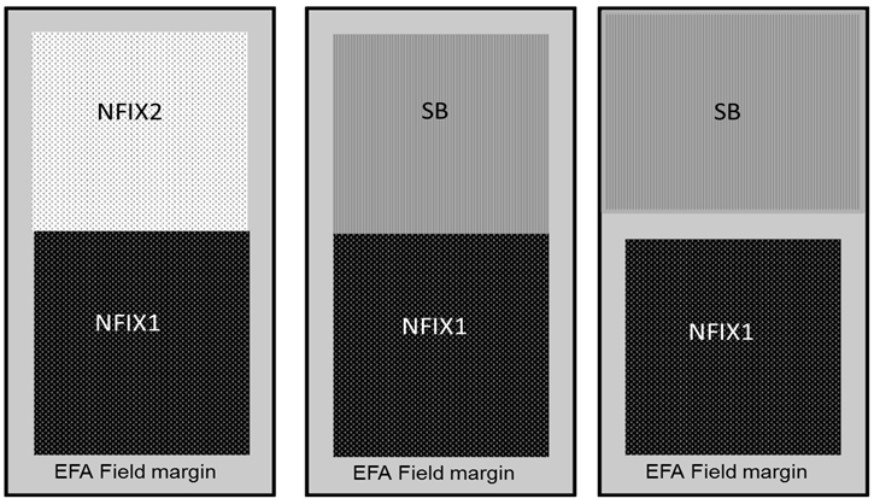
EFA hedges (EFAH)
Hedges provide a habitat and wildlife corridor for a variety of farmland birds, insects and mammals.
They increase farmland biodiversity and also protect arable crops from the wind, thereby reducing soil erosion.
What is an EFA hedge?
An EFA Hedge is:
- any hedge having a length of at least 20 metres or a length of less than 20 metres where it meets another hedge at each end. Any gap of less than 20 metres is treated as being part of the hedge
- a GAEC landscape feature and as such has no land cover and is fully eligible for BPS
What land is eligible to support an EFA Hedge?
Your hedge:
- must be on or within five metres of arable land or contiguous to a claimed EFA option in such a way that the longest edge of the hedge is parallel to the field
- must be on your holding, or under your control/responsibility, on a claimed or adjacent to a claimed parcel (see diagram 10), that is BPS eligible and claimed on your SAF
- can be any height but must be up to and including three metres wide from the centre of the hedge (hedges wider than three metres from the centre of the hedge are BPS and EFA ineligible)
How much does my EFA Hedge contribute to my EFA requirement?
- an EFA Hedge is a linear feature. Each linear metre is worth 10 m2 of EFA contribution if claimed in its entirety
- if the EFA Hedge forms a boundary between two parcels, the hedge in each parcel will count as 5 m2 (50 percent) of EFA contribution
Requirements for EFA Hedges
You must:
- if you want to claim a newly planted hedge as an EFA Hedge it must have been established before the BPS application is submitted (prior to the 15th May)
- submit an EFA map with your Single Application Form, detailing the location and length of your EFA Hedge. See EFA Mapping Requirements
- manage EFA Hedges in accordance with Cross Compliance (GAEC 7 – Retention of landscape features) - cross compliance guidance
You must not:
- remove or destroy hedges without the written consent of the Scottish Ministers
- trim hedges or lop branches off trees during the bird nesting and rearing season starting on 1 March and ending on 31 August except for road safety reasons. Hedgelaying can be carried out up to and including 31 March
- cultivate land within two metres of the centre line of a hedge unless one of the following exemptions apply:
- cultivating to establish a green cover where one doesn’t already exist. A green cover excludes crops that are grown for a commercial purpose, e.g. arable crops including crops that are under sown with grass
- cultivating to establish a new hedge - apply fertilisers (organic manure, chemical or nitrogen) or pesticides within two metres of the centre line of a hedge unless one of the following exemptions apply:
- applications of fertilisers or pesticides to establish a new hedge. This applies from the time the land is prepared for planting the new hedge to the end of the hedge’s third growing season
- spot application of pesticides to control injurious weeds, invasive species and, after prior written consent of the Scottish Ministers and / or other statutory bodies, certain other weed species
Helpful tips for EFA hedges
- hedges can include gaps, provided that no individual gap is greater than 20 metres
- if a hedge contains any individual trees then they are considered as part of the hedge
- if the hedge is a boundary between two fields half the hedge should be claimed against each field
- if you want to include areas in your EFA that are currently part of an agri-environment scheme you can do this. However:
- you must ensure that the management of the two schemes are compatible
- the payment you receive for your agri-environment scheme may be reduced to reflect the Greening payment you receive for your EFA feature
- there may be delays in the payment of your Basic Payment as both schemes will need to be validated
How do I claim an EFA hedge?
Example one – EFA hedge adjacent to the boundary of a BPS claimed field
In this example the hedge is eligible to be claimed as an EFA hedge as it is within five metres of arable land and although the hedge is outside the field it is under the control/responsibility of the farmer and is adjacent to the BPS claimed field.
In this instance the EFA Hedge is 100 percent attributable to the farmer and can be claimed using the code EFAH100.
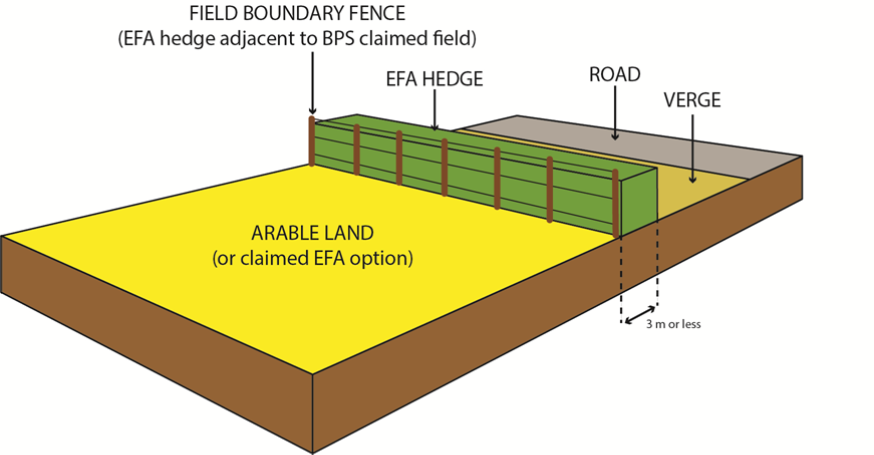
Example two – EFA hedge with a road adjacent to it
In this example the hedge is eligible to be claimed as an EFA hedge as the hedge is greater than 20 metres in length and it is within five metres of arable land. The farmer will claim using code EFAH100.
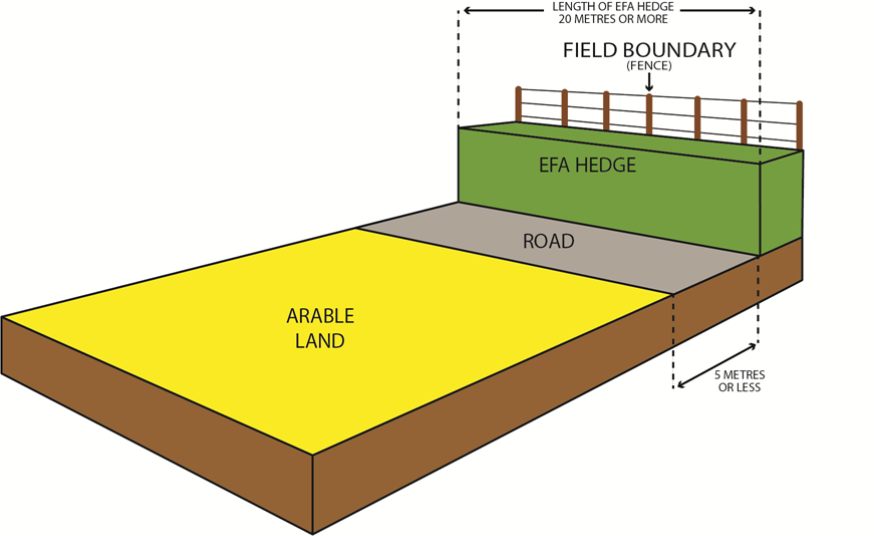
Example three – hedge with only shortest side touching arable land
In this example the hedge is ineligible to be claimed as an EFA hedge as the hedge is surrounded by permanent grassland on its longest sides and is only adjacent to arable land on its shortest side.
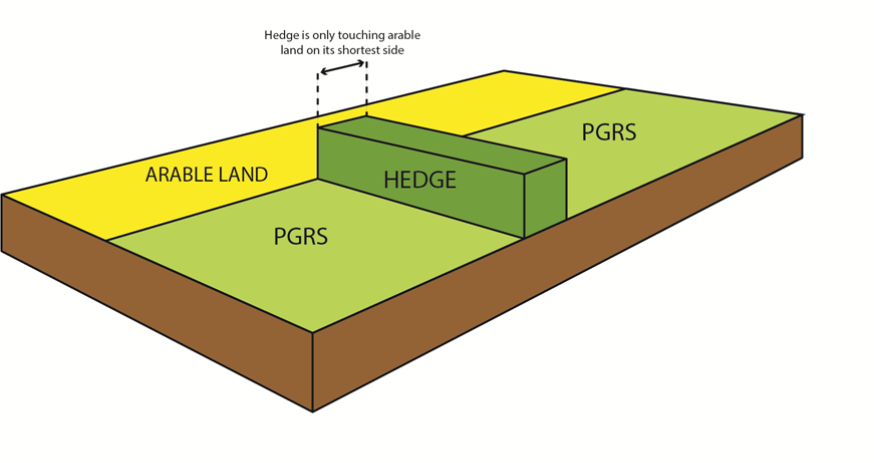
Example four (A) – hedge claimed as an EFA hedge shared between two farmers
In this example a ‘march’ hedge is to be claimed as an EFA hedge by both farmer A and farmer B. As the field boundary runs along the centre of the hedge, each can claim their respective half of the hedge.
Both farmer A and farmer B would claim using code EFAH50 for their respective half of the hedge.
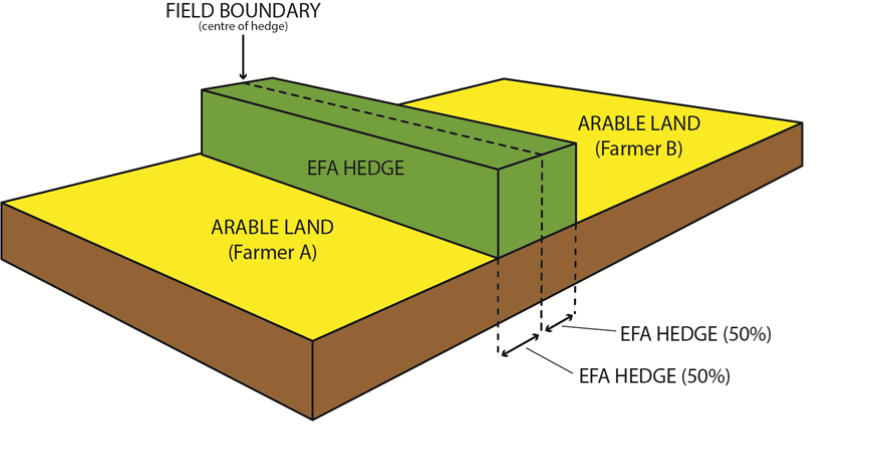
Example four (B) – boundary hedge between two arable parcels claimed as an EFA hedge by one farmer
In this example, the field boundary runs along the centre of the hedge. Farmer A can claim either EFAH50 in both of the parcels or claim EFAH100 in one of the parcels.
Please note the entirety of the hedge can only be claimed once, either claiming EFAH50 twice or EFAH100 once.
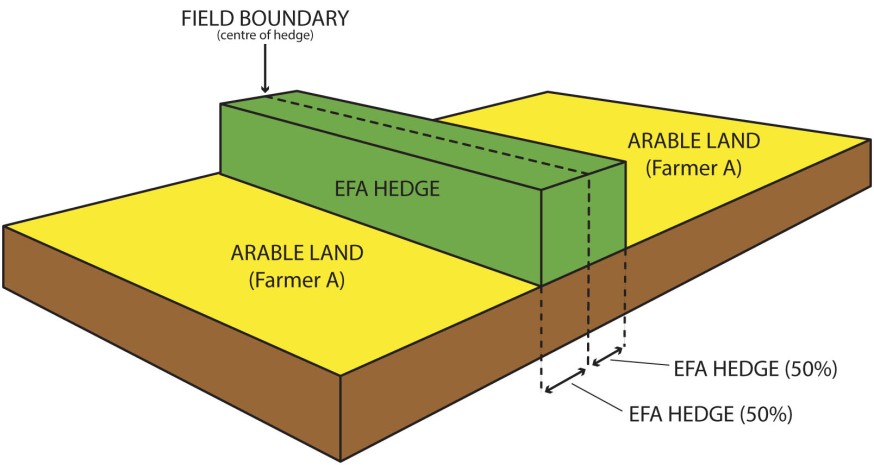
Example five – hedge claimed as an EFA hedge by one farmer
In this example the hedge is to be claimed as an EFA hedge by only farmer A as the field boundary stops on the fence, only farmer A can claim the hedge and will claim 100 percent, using the code EFAH100
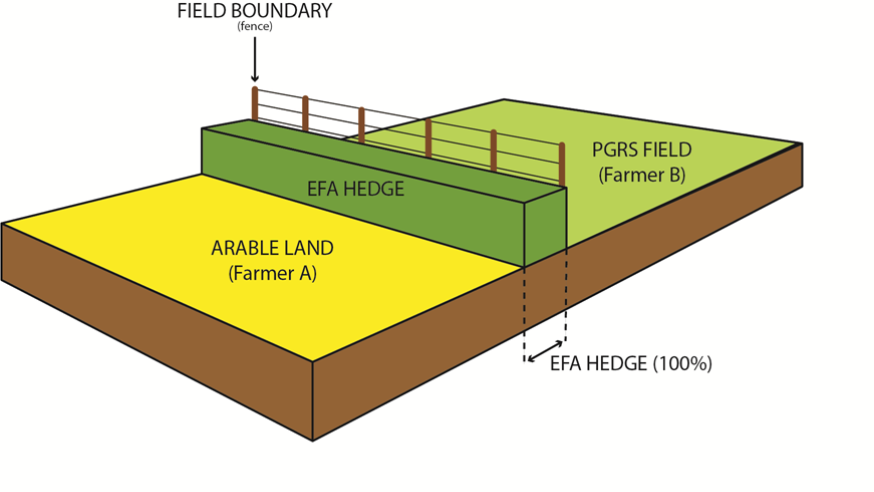
EFA agro-forestry (EFAAF)
The environmental benefits of agro-forestry systems are that they provide a diversity of habitats for wildlife and can reduce run-off and soil erosion.
What land is eligible to support EFA Agro-forestry?
Your land:
- must have been BPS eligible, arable land in 2015
- must have been planted under a FGS (Pillar 2) Scheme since 2015
Requirements for EFA Agro-forestry
You must:
- submit an EFA map with your Single Application Form, detailing the location and size of your EFA Agro-forestry. See EFA Mapping Requirements
- ensure that the area is subject to an agreement with the Forestry Commission under agro-forestry and have been planted since 1 January 2015
Helpful tips for EFA Agro-forestry
- for further details regarding agro-forestry requirements, please refer to the Forestry Grant Scheme guidance
- if you want to include areas in your EFA that are currently part of an agro-forestry grant scheme you can do this. However:
- you must ensure that the management of the two schemes are compatible.
- the payment you receive for your agro-forestry grant scheme may be reduced to reflect the Greening payment you receive for your EFA feature
- there may be delays in the payment of your Basic Payment as both schemes will need to be validated
General tips for all EFA options
- all land claimed for EFA is not eligible for LFASS payments
- if you are unsure if your use of an area for access or tracking is more than occasional use then you should not use this as an EFA fallow area. Any consequences arising from access by a third party inconsistent with the Land Reform Act and the associated access guides will not be considered a breach of an EFA.
- the definition of ‘plant protection products’ can be found at the following link: Definition of Pesticides
- if you use temporary grass as EFA fallow, this land will retain its arable status for Greening purposes (including your commitment to have five per cent of your arable land subject to EFA and crop diversification). This applies for as long as you continue to use it for EFA fallow even if the grass becomes more than five years old
- remember – your arable land includes any temporary grassland that you include in a crop rotation. Temporary grassland is grassland that is five years old or less. If you plough permanent grass and immediately sow a new grass ley, the land will retain its status as permanent grass and does not become temporary grass
- if you choose to claim an EFA margin on permanent grassland, open grazed woodland or rough grazing – it must be adjacent to, or within five metres of arable land or contiguous to a claimed EFA option. You must claim this land as Permanent Cover (PC) on your Single Application Form. This permanent cover will be considered as arable land when calculating your total area of arable land for your Greening requirements including the area of EFA
- if you wish to undertake multiple EFA options in one field you can do this as long as you meet all the eligibility requirements of each and you are able to distinguish the location and extent of each option. In a practical example, this means you could have an area of fallow surrounded by a margin
- land can only count once as EFA so as detailed above you may have different EFA options in the same field but the land can only contribute to your EFA commitment once. For example it cannot be EFA fallow and EFA green cover in the same claim year
- many elements of EFA are complementary to GAEC. This means that margins or hedges can meet both GAEC and EFA requirements and be eligible land for the Basic Payment Scheme. Refer to the Overview for guidance on GAEC requirements
- there is no upper limit to the area you can manage and claim as EFA. So if you have a commitment of 10.6 hectares you can manage and claim above this figure. For example, 12.2 hectares, if you wish
- if you want to include areas in your EFA that are currently part of an agri-environment scheme you can do this. However:
- you must ensure that the management of the two schemes are compatible.
- the payment you receive for your agri-environment scheme may be reduced to reflect the Greening payment you receive for your EFA feature
- there may be delays in the payment of your Basic Payment as both schemes will need to be validated
Flexibility under Greening rules
| What is permitted under Scottish Greening rules within the Ecological Focus Areas (EFA's) as of 16 August, 2018. | |
|---|---|
| EFA fallow | Although no agricultural activity is allowed in EFA fallow between 15 January and 15 July, agricultural activity can be resumed after 15 July. |
| EFA margins | Can be grazed or cut from 15 July with the exception that livestock cannot graze in margins that contain or are adjacent to a watercourse. |
| EFA catch crops | The catch crop (grass) must be maintained until 31 December however, grazing can take place after the nurse crop (cereal) has been harvested. |
| EFA green cover | Although no agricultural activity is allowed on green cover between 1 November and 31 December (the maintenance period), agricultural activity can resume after 31 December, allowing for spring grazing. |
| EFA nitrogen fixing crops | Can be grazed or cut after 1 August with the exception that livestock cannot graze in margins that contain or are adjacent to a watercourse. |
Recent changes
| Section | Change |
|---|---|
| I'm Organic, am I exempt? | Added reminder to submit certificate along with SAF |
| Mapping requirements | Section replaced due to the introduction of the new map viewer and facility to suit EFA map. |
| Do the EFA requirements apply to me? | Only Scottish land counts for Cross border businesses greening calculations |
Previous versions
Download guidance
Click 'Download this page' to create a printable version of this guidance you can save or print out.
